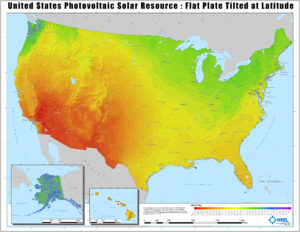Uptake of Solar Heating in Small Apartment Properties Slow, Skewed to South-West

Making an apartment community more energy efficient can boost NOI by reducing operating expenses. While gas and electric power the majority of America’s housing stock, the use of solar thermal heating has increased by 19% from 2010 to 2015.
Metro Level Solar Adoption Trends in Apartment Properties
Of course, solar heating makes more economical sense in certain markets. As expected, metro areas with the highest year-round solar insolation — that is, how much sunlight hits the earth’s surface — have the highest uptake of solar heating technologies in multifamily properties. These are the orange and red areas in the map of solar insolation below.
Click to Enlarge. (Source: National Renewable Energy Laboratory)
As noted in our first examination of solar heating in apartments, the adoption of solar powered heating systems is extremely low across housing, especially for apartment properties. While the technology has improved drastically since the first solar heated home debuted in 1955, only four out of every 10,000 small asset apartment (properties with between 5-49 units) units have adopted the technology. The rate is twice as high in apartment properties with more than 50 units.
As shown below, the adoption of solar heating in small properties is limited to a small number of metros. There is also a wide range in adoption levels that corresponds to the solar insolation rates referenced above.
Metros in the Southwest and West — such as Salt Late City, Austin and San Diego — saw three to five times higher rates of adoption compared to the national small property average.
Gateway cities are led by Boston, Washington DC and San Francisco with higher than average national rates, while Los Angeles, New York and Chicago have the largest numbers overall.
In comparison, solar technology uptake in large properties is represented by a slightly wider swath of the United States, with Boston, Sacramento and Chicago showing the highest rates of adoption per 10,000 units.
Los Angeles and New York, while largest in numbers, are again significantly low in terms of technology penetration.
Growth in Solar
One additional interesting trend to explore is growth in the types of assets utilizing solar heating. As shown below, while large apartment assets and the general housing market are more likely to use solar heating, the technology’s growth rate is the fastest in small apartment assets.
How You Go Green
While we continue to track and understand the spread of renewable technologies in the US apartment sector, we have put together a few resources to help you understand exactly how sustainable retrofits can help improve your bottom line.
Arbor’s recent white paper “The Business Case for Green Multifamily Financing” includes case studies on energy retrofits and an overview of financing programs that provide discounted loan rates.
Further, a comprehensive list of municipal and state level incentives across the United States are presented at the Department of Energy (DOE) sponsored Database of State Incentives for Renewables & Efficiency (DSIRE).


